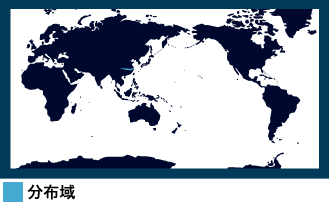- TOP
- ECOLOGY
- Cetaceans Around the World
- Encyclopedia of the Whales
Toothed Whales
Toothed Whales
 Sperm whale
Sperm whale
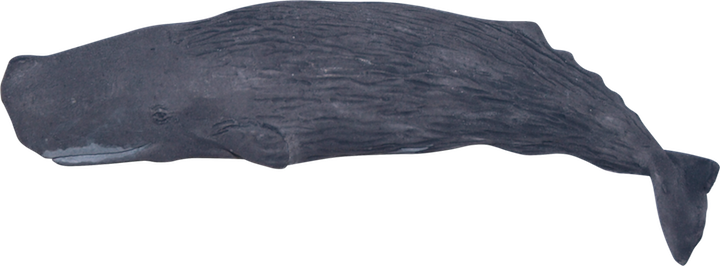
マッコウクジラ
Sperm whale
マッコウクジラ科/Physeter macrocephalus
Maximum length:18 m
Sperm whales are the largest toothed whales and have blowholes on the left sides of their heads, which makes them unique in blowing water forward.
They are found in all of the oceans in the world, and the males migrate to warmer waters to breed.
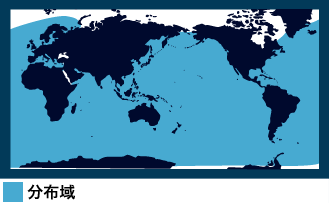
 Pygmy sperm whale
Pygmy sperm whale
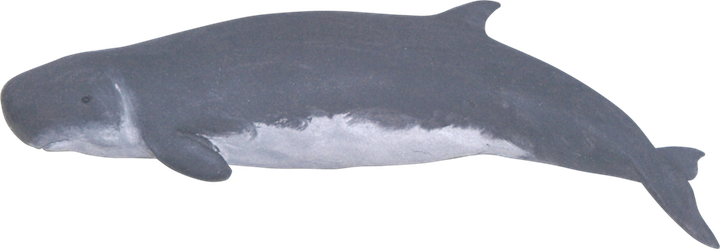
コマッコウ
Pygmy sperm whale
コマッコウ科/Kogia breviceps
Maximum length:3.4 m
Pygmy sperm whales are slightly larger than dwarf sperm whales, and their dorsal fins are smaller and positioned further back.
They are found in tropical and warm waters all over the world.

 Dwarf sperm whale
Dwarf sperm whale

オガワコマッコウ
Dwarf sperm whale
コマッコウ科/Kogia sima
Maximum length: 2.7 m
Smaller than pygmy sperm whales, dwarf sperm whales have higher dorsal fins near the center of their backs.
They are found in tropical and warm waters all over the world.
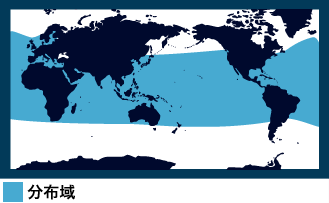
 Baird's beaked whale
Baird's beaked whale

ツチクジラ
Baird's beaked whale
アカボウクジラ科/Berardius bairdii
Maximum length: 12.8 m
Baird’s beaked whales are the largest of the Berardius bairdii. The males and the females alike develop large, flat teeth along their lower jaws as they approach adulthood.
They are only found in the colder areas of the Pacific Ocean.
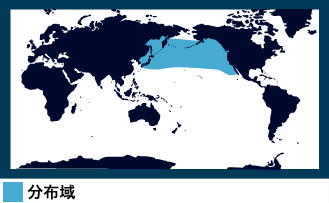
 Arnoux's beaked whale
Arnoux's beaked whale

ミナミツチクジラ
Arnoux's beaked whale
アカボウクジラ科/Berardius arnuxii
Maximum length: 9.75 m
Long beaks with large heads and small, angled dorsal fins are the prominent characteristics of Arnoux’s beaked whales.
They are found in the Southern Ocean around Antarctica.
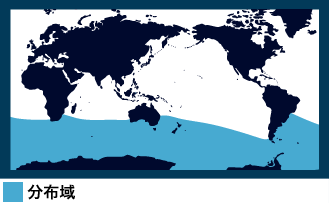
 Northern bottlenose whale
Northern bottlenose whale

キタトックリクジラ
Northern bottlenose whale
アカボウクジラ科/Hyperoodon ampullatus
Maximum length: 9.8 m
Male northern bottlenose whales have protruding foreheads with flat faces.
They are only found in the colder areas of the North Pacific Ocean and the Arctic Ocean.
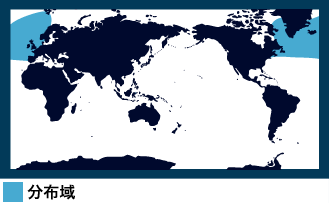
 Southern bottlenose whale
Southern bottlenose whale

ミナミトックリクジラ
Southern bottlenose whale
アカボウクジラ科/Hyperoodon planifrons
Maximum length: 7.8 m
Aside from their thicker beaks, huge, bulging foreheads are prominent in adult males. Adult males also have two, slightly forward-leaning teeth along their lower jaws.
They are found in the Southern Hemisphere in a wide area around the Antarctic at 29 degrees south latitude or more.
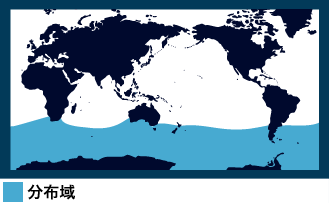
 Cuvier's beaked whale
Cuvier's beaked whale

アカボウクジラ
Cuvier's beaked whale
アカボウクジラ科/Ziphius cavirostris
Maximum length: 7.5 m
Cuvier’s beaked whales have robust bodies, short foreheads, and short beaks that are similar to geese. Ziphius cavirostris have characteristic dorsal fins, pectoral fins, and V-shaped ridges on their throats.
They are found in tropical and cold, temperate oceans all over the world.
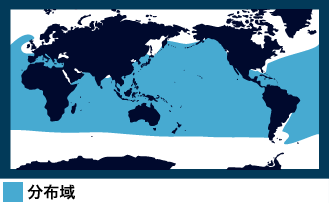
 Longman's beaked whale
Longman's beaked whale

タイヘイヨウアカボウモドキ (ロングマンオウギハクジラ)
Longman's beaked whale
アカボウクジラ科/Indopacetus pacificus
Maximum length: 6.5 m
Longman’s beaked whales have bright foreheads that are almost perpendicular to their long beaks, large dorsal fins, and white spots that cover their bellies and sides.
They are only found in the tropical Indo-Pacific Ocean between the western coasts of Mexico and the eastern coasts of Africa and the Gulf of Aden.
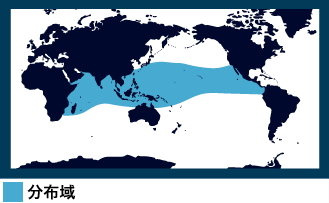
 Hector's beaked whale
Hector's beaked whale

ニュージーランドオウギハクジラ
Hector's beaked whale
アカボウクジラ科/Mesoplodon hectori
Maximum length: 4.4 m
The smallest of its kind, Hector’s beaked whales have short, yet distinct beaks. Adult males have protruding teeth on both sides of their lower jaws.
Hector’s beaked whales are only found in the Southern Hemisphere.

 True's beaked whale
True's beaked whale

アカボウモドキ
True's beaked whale
アカボウクジラ科/Mesoplodon mirus
Maximum length: 5 m
True’s beaked whales have dorsal fins that are small and either angled or hooked, and their heads resemble those of dolphins. Adult males develop a pair of teeth that slightly protrude from their lower jaws.
They are found in the North Atlantic Ocean and in the Southern Hemisphere (particularly in the South Atlantic Ocean).
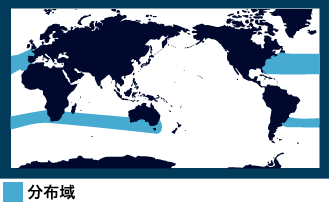
 Sowerby's beaked whale
Sowerby's beaked whale

ヨーロッパオウギハクジラ
Sowerby's beaked whale
アカボウクジラ科/Mesoplodon bidens
Maximum length 5.5 m
Sowerby’s beaked whales have moderately long beaks, and their dorsal fins are located along their lower backs. The males develop small, triangular teeth which protrude from the raised part of their lower jaws. Unique to the North Pacific Ocean,
They are found mostly in cold, temperate, and subarctic waters.

 Gray's beaked whale
Gray's beaked whale

ミナミオウギハクジラ
Gray's beaked whale
アカボウクジラ科/Mesoplodon grayi
Maximum length: 5.6 m
Gray’s beaked whales have small heads and long, white beaks. Adult males and some females develop a pair of small teeth in the center of their lower jaws.
They are only found in the Southern Hemisphere generally in cold, temperate waters around 30 degrees south latitude or more.
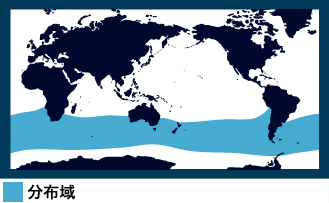
 Andrews' beaked whale
Andrews' beaked whale

タイヘイヨウオウギハクジラ
Andrews' beaked whale
アカボウクジラ科/Mesoplodon bowdoini
Maximum length: 4.7 m
Andrew’s beaked whales have short, fat beaks and small heads. Apart from the white beaks of the adult males, their bodies are dark gray or black, and many of them have long scars from getting bitten.
They are only found in the cold, temperate zone in the Southern Hemisphere (near the Antarctic between 32-54.3 degrees south latitude).
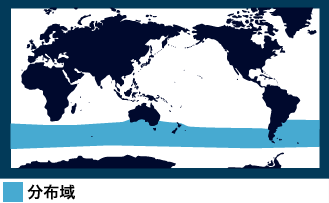
 Hubbs' beaked whale
Hubbs' beaked whale

ハッブスオウギハクジラ
Hubbs' beaked whale
アカボウクジラ科/Mesoplodon carlhubbsi
Maximum length: 5.3 m
Adult male Hubbs’ beaked whales have a protruding heads with white beaks which look like hats. They also develop large teeth on their lower jaws that grow past their beaks.
They are only found in the cold, temperate zone in the North Atlantic Ocean (generally between 32-54 degrees north latitude).
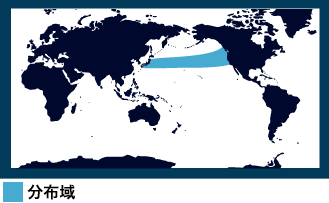
 Ginkgo-toothed beaked whale
Ginkgo-toothed beaked whale

イチョウハクジラ
Ginkgo-toothed beaked whale
アカボウクジラ科/Mesoplodon ginkgodens
Maximum length: 4.9 m
The ginkgo-leaf-shaped teeth of the adult males are the prominent characteristics of the ginkgo-toothed beak whale. Unique to Mesoplodont whales, their bodies are not covered with lines of scars.
They are usually found in the Western Pacific Ocean, but little is known as they are rarely identified alive.
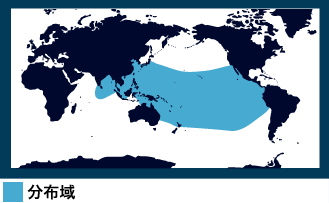
 Stejneger's beaked whale
Stejneger's beaked whale
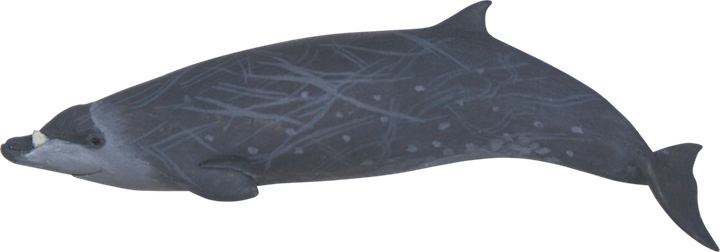
オウギハクジラ
Stejneger's beaked whale
アカボウクジラ科/Mesoplodon stejnegeri
Maximum length: 5.3 m
Adult male Stejneger’s beaked whales have tapered, flat foreheads that smoothly connect to their beaks. Their teeth grow out of their lower jaws. The white coloring from their beaks to their eyes gives them a “capped” appearance.
They are indigenous to the cold, temperate waters of the North Pacific Ocean and the Bering Sea near the arctic.
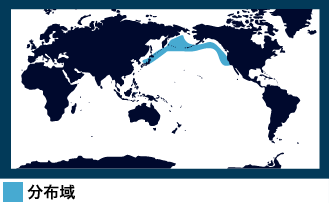
 Blainville's beaked whale
Blainville's beaked whale

コブハクジラ
Blainville's beaked whale
アカボウクジラ科/Mesoplodon densirostris
Maximum length: 4.7 m
The prominent characteristics of Blainville’s beaked whales are their swollen, arched, lower jaws, especially among the adult males. Large teeth grow from the front of the arch of their lower jaws.
They are found in tropical and temperate waters all over the world.
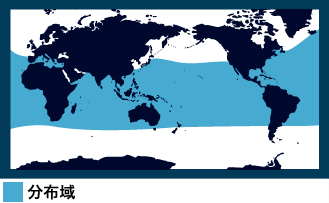
 Strap-toothed whale
Strap-toothed whale
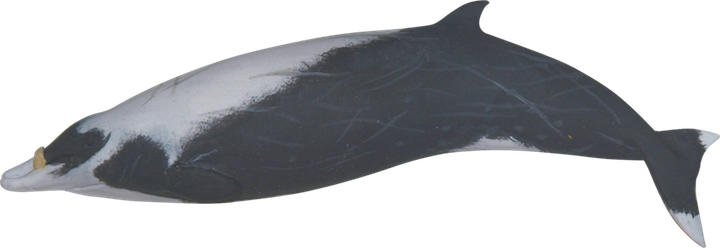
ヒモハクジラ
Strap-toothed whale
アカボウクジラ科/Mesoplodon layardii
Maximum length: 6.2 m
The largest of Mesoplodont whales, the strap-toothed whale, has distinctive black and white coloring and long, lower jaw teeth that grow backward at a 45 degree angle.
They live in cold, temperate waters between 35-60 degrees south latitude.
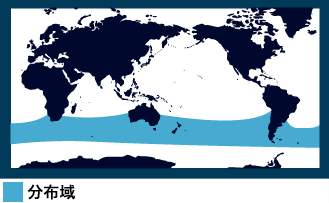
 Perrin's beaked whale
Perrin's beaked whale

ペリンオウギハクジラ
Perrin's beaked whale
アカボウクジラ科/Mesoplodon perrini
Maximum length: 4.4 m
Perrin’s beaked whales have small heads with rather short beaks. The lines of their mouths are straight, and only adult males develop a pair of wide teeth near the ends of their lower jaws. A dark colored line extends from their eyes to the back part of their blowholes.
They have only been found in the eastern part of the North Pacific Ocean.

 Pygmy beaked whale
Pygmy beaked whale

ペルーオウギハクジラ(ピグミーオウギハクジラ)
Pygmy beaked whale
アカボウクジラ科/Mesoplodon peruvianus
Maximum length: 3.7 m
Pygmy beaked whales are the smallest species of the Mesoplodont whales. Adult males have a white, inverted V shape on their backs.
They have only been found in the Pacific Ocean.
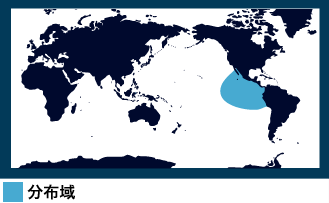
 Shepherd's beaked whale
Shepherd's beaked whale

タスマニアクチバシクジラ(タスマニアクジラ)
Shepherd's beaked whale
アカボウクジラ科/Tasmacetus shepherdi
Maximum length: 7 m
Shepherd’s beaked whales are the only species of Ziphliid that fully develop teeth along both their upper and lower jaws. Their beaks are long and prominent compared to their foreheads.
They are found across a large area in cold, temperate waters between 30-55 degrees south latitude.
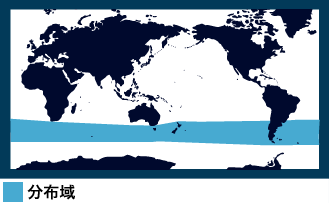
 Gervais' beaked whale
Gervais' beaked whale

ジェルヴェオウギハクジラ(ヒガシアメリカオウギハクジラ)
Gervais' beaked whale
アカボウクジラ科/Mesoplodon europaeus
Maximum length: 5.2 m
Gervais’ beaked whales have smaller heads compared to other Mesoplodont whales. A straight mouth-line and a distinctive pair of teeth are prominent characteristics of adult males.
They are only found in the Pacific Ocean mainly in tropical and temperate waters.
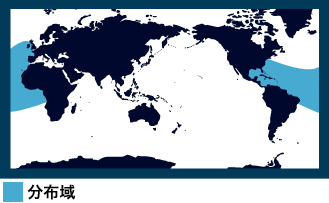
 Short-beaked common dolphin
Short-beaked common dolphin
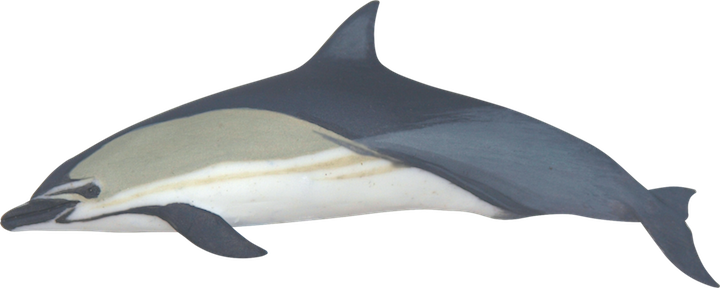
マイルカ
Short-beaked common dolphin
マイルカ科/Delphinus delphis
Maximum length: 2.6 m
The short-beaked common dolphin is smaller than the long-beaked common dolphin, and they have shorter beaks as well. Their coloring is darker and they have characteristic light, dark gray, or yellow lines in a crisscross pattern on their sides.
They are found in warm and cold, temperate waters in the Pacific and the Atlantic Oceans both in open and coastal waters.
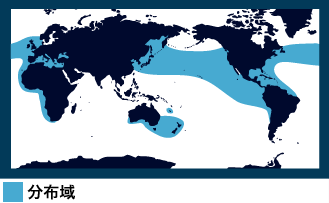
 Long-beaked common dolphin
Long-beaked common dolphin
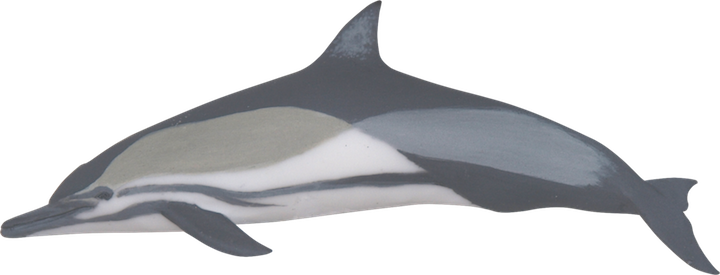
ハセイルカ
Long-beaked common dolphin
マイルカ科/Delphinus capensis
Maximum length: 2.4 m
Larger than short-beaked common dolphins, long-beaked common dolphins have longer beaks and their coloring is lighter. They have characteristic light, dark gray, or yellow lines in a crisscross pattern on their sides which are common to long and short-beaked common dolphins.
They are found in shallow tropical and subtropical waters in the Pacific, Atlantic, and Indian Oceans.
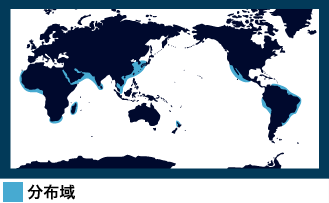
 Common bottlenose dolphin
Common bottlenose dolphin
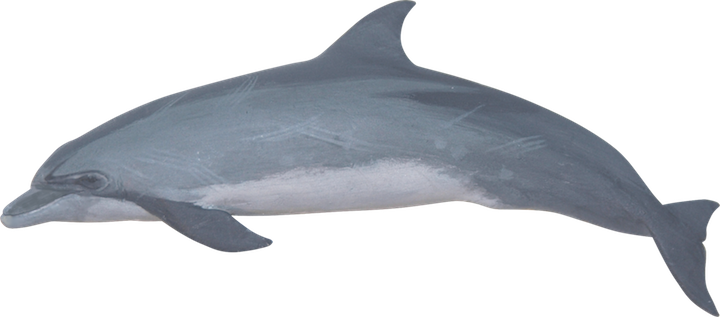
ハンドウイルカ(バンドウイルカ)
Common bottlenose dolphin
マイルカ科/Tursiops truncatus
Maximum length: 3.8 m
The common bottlenose dolphin is the most well-known species of dolphin. The males are larger than the females, and they have fat, short, cylindrical beaks that are distinctive from their prominent heads and separated by a crease.
They live in temperate and tropical waters where the water temperature ranges from 10-32 degrees Celsius.
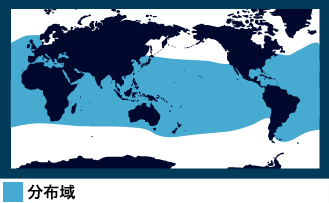
 Indo-pacific bottlenose dolphin
Indo-pacific bottlenose dolphin
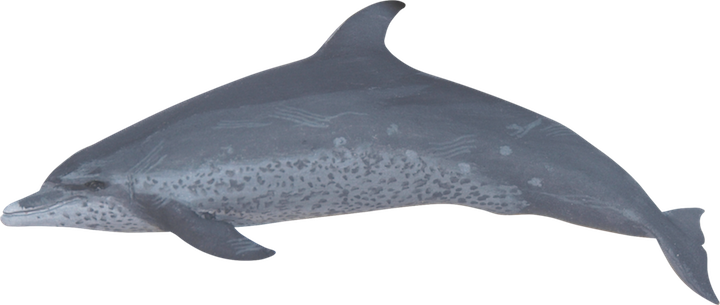
ミナミハンドウイルカ
Indo-pacific bottlenose dolphin
マイルカ科/Tursiops aduncus
Maximum length: 2.5 m
Rather small in size and thin in shape, Indo-pacific bottlenose dolphins have longer beaks than common bottlenose dolphins. Some populations develop dark spots on their bellies as they mature.
They live in temperate and tropical waters in the Indian and Western Pacific Oceans.
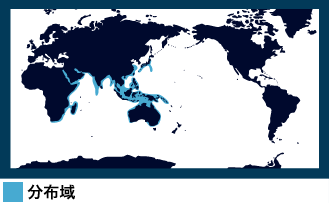
 Indian humpback dolphin
Indian humpback dolphin
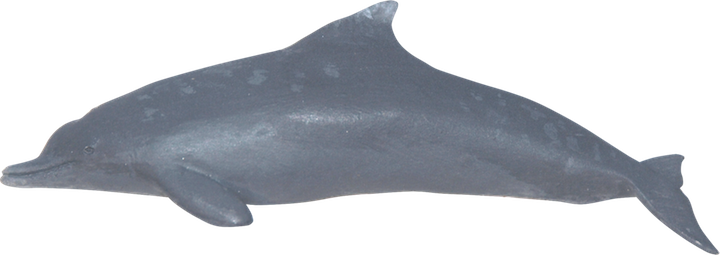
ウスイロイルカ
Indian humpback dolphin
マイルカ科/Sousa plumbea
Maximum length: 2.8 m
The largest in the genus Sousa, Indian humpback dolphins have small, hooked dorsal fins on a large hump on their backs.
They are observed in waters ranging from the southwestern coast of South Africa to the coastal waters of Myanmar in the Indian Ocean.
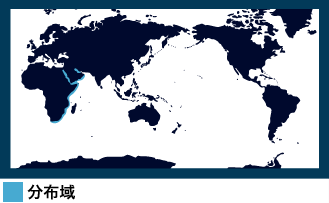
 Indo-pacific humpback dolphin
Indo-pacific humpback dolphin
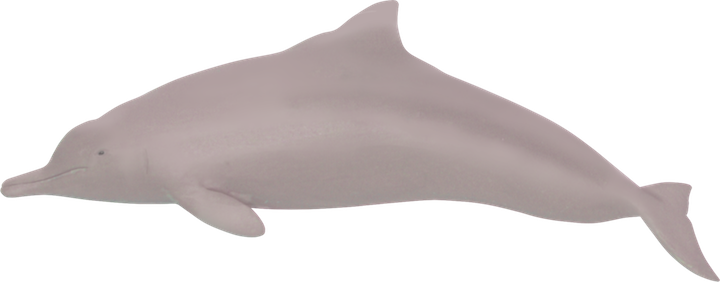
シナウスイロイルカ
Indo-pacific humpback dolphin
マイルカ科/Sousa chinensis
Maximum length: 3.2 m
Indo-pacific humpback dolphins have characteristic triangular-shaped dorsal fins without a hump. While their coloring is commonly gray, some become different colors as they mature depending on the area where they are found.
They are found in areas between eastern India and central China in the tropical and temperate waters of Southeastern Asia.

 Rough-toothed dolphin
Rough-toothed dolphin
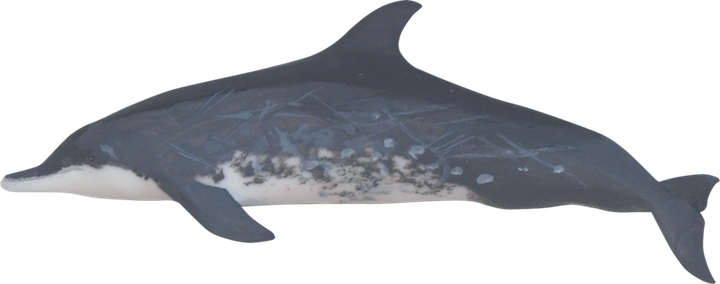
シワハイルカ
Rough-toothed dolphin
マイルカ科/Steno bredanensis
Maximum length: 2.8 m
Compared to other dolphins, rough-toothed dolphins have long pectoral fins positioned along their lower backs, and males have white patches from their sides to their bellies. Their teeth, which grow along their upper and lower jaws, have vertical lines on the surface.
They can be found in tropical and temperate waters all over the world.
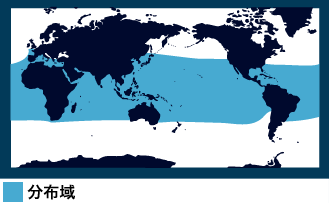
 Striped dolphin
Striped dolphin
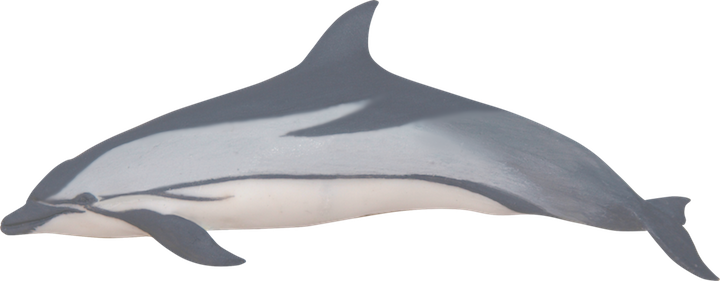
スジイルカ
Striped dolphin
マイルカ科/Stenella coeruleoalba
Maximum length: 2.6 m
Striped dolphins have thin lines that stretch from their eyes to their pectoral fins and to their anuses. They are strong and have distinctive bright and dark coloring.
They are found in tropical and temperate waters all over the world.
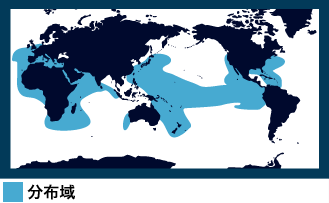
 Pantropical spotted dolphin
Pantropical spotted dolphin
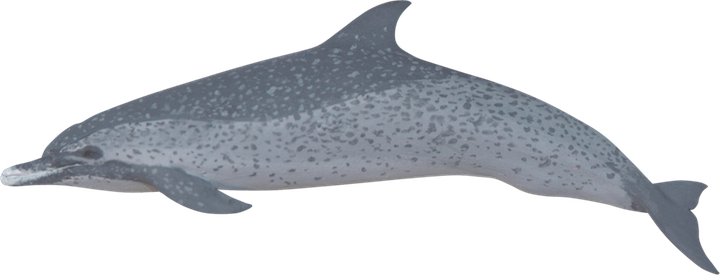
マダライルカ
Pantropical spotted dolphin
マイルカ科/Stenella attenuata
Maximum length: 2.6 m
Smaller than other dolphins, pantropical spotted dolphins have slender bodies, long, thin beaks, and spots that appear on their bodies as they age. Some adults have beaks with white edges.
They live in tropical, subtropical, and temperate waters all over the world.
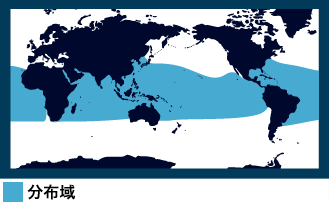
 Atlantic spotted dolphin
Atlantic spotted dolphin
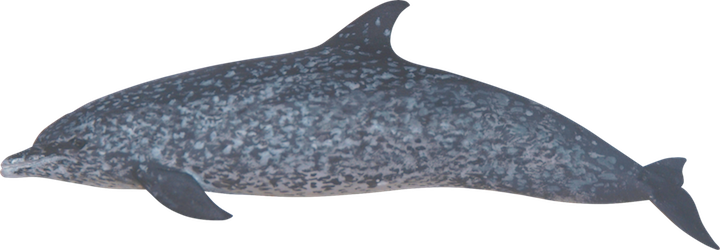
タイセイヨウマダライルカ
Atlantic spotted dolphin
マイルカ科/Stenella frontalis
Maximum length: 2.3 m
Atlantic spotted dolphins change color as they mature. While born gray and white, they develop small patches of black on their bellies and white on their backs, which eventually cover their entire bodies.
They are indigenous to the tropical and temperate waters of the Atlantic Ocean (including the Gulf of Mexico but excluding the Mediterranean Sea).

 Spinner dolphin
Spinner dolphin
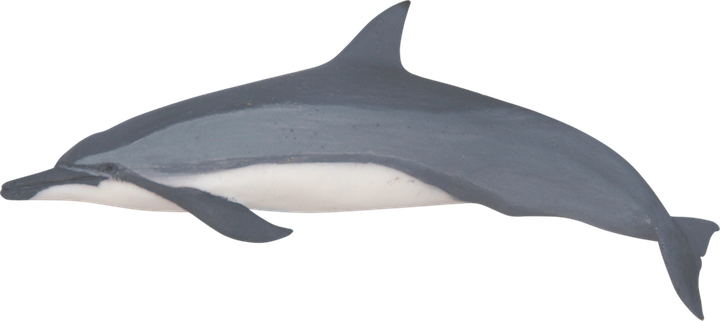
ハシナガイルカ
Spinner dolphin
マイルカ科/Stenella longirostris
Maximum length: 2.4 m
Spinner dolphins are small and slender. These dolphins have two types of coloration—single colored and triple colored, and the shapes of their dorsal fins differ largely among sex and subspecies. Long, dark lines that run from their eyes to their pectoral fins are characteristic of them.
They live in tropical and subtropical waters in both hemispheres between 40 degrees north and south latitude.
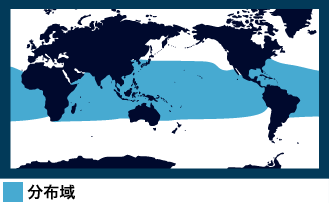
 Clymene dolphin
Clymene dolphin
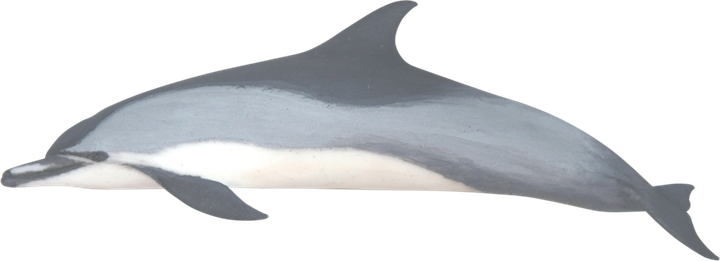
クライメンイルカ
Clymene dolphin
マイルカ科/Stenella clymene
Maximum length: 2 m
Most of the Clymene dolphins have gray backs, light gray sides, and white bellies. The edges of their beaks are black, which look like “moustaches.”
They are only found in the deep tropical and subtropical waters of the Atlantic Ocean.
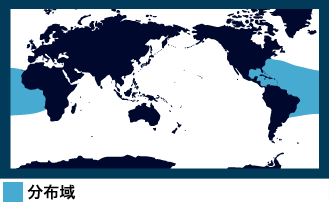
 Fraser's dolphin
Fraser's dolphin
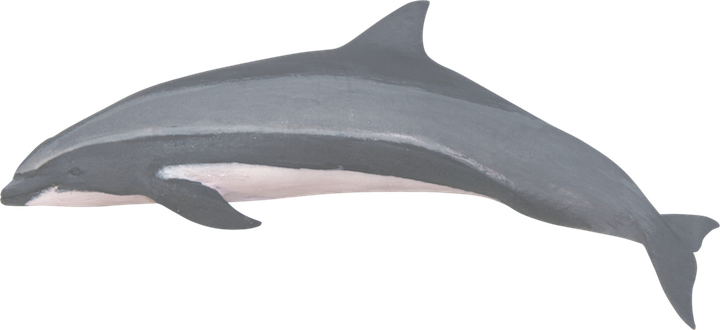
サラワクイルカ
Fraser's dolphin
マイルカ科/Lagenodelphis hosei
Maximum length: 2.7 m
Adult male Fraser’s dolphins have characteristic black lines that run from their faces to their anuses, and dark-colored lines that run from the center of their lower jaws up to their pectoral fins. Their backs are dark or brownish gray, while their bellies are white or pink at times.
While they can be found in open, tropical waters, some have been found in deeper, coastal waters.
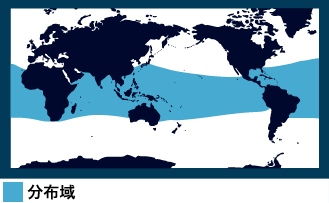
 Northern right whale dolphin
Northern right whale dolphin
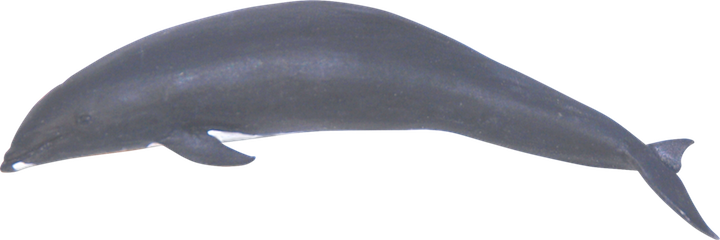
セミイルカ
Northern right whale dolphin
マイルカ科/Lissodelphis borealis
Maximum length: 3.1 m
Northern right whale dolphins do not have dorsal fins, and their pectoral and caudal fins are small. Their bodies taper off and become thinner at their posterior ends, giving them an eel-like shape. Their bodies are mostly black with a white belt on their bellies and white spots beneath their lower jaws.
They are found in the temperate waters of the North Pacific Ocean between 30-55 degrees north latitude.
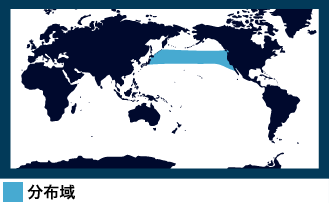
 Southern right whale dolphin
Southern right whale dolphin
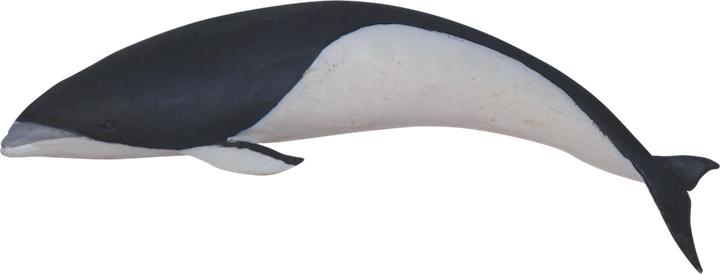
シロハラセミイルカ
Southern right whale dolphin
マイルカ科/Lissodelphis peronii
Maximum length: 3 m
Southern right whale dolphins have slender bodies without dorsal fins. The black and white on their bodies contrast vividly. Their pectoral fins and the sides of their bellies are white, and their backs, excluding their faces and throats, are black. Their characteristics include short beaks, a rather flat forehead, and a straight mouth-line.
They are found in the Antarctic and cold, temperate waters between 40-55 degrees south latitude.
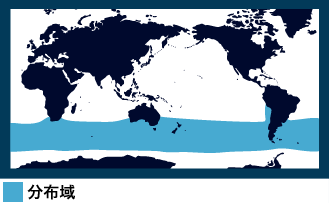
 Pacific white-sided dolphin
Pacific white-sided dolphin

カマイルカ
Pacific white-sided dolphin
マイルカ科/Lagenorhynchus obliquidens
Maximum length: 2.5 m
Pacific white-sided dolphins are larger than the related southern right whale dolphin. They have large, hooked, dorsal fins which are divided into two colors and have light gray lines on their sides that look like “suspenders.”
They live in cold, temperate waters in the North Pacific Ocean (from California to the Bering Sea along with the northern waters of Taiwan).

 Atlantic white-sided dolphin
Atlantic white-sided dolphin
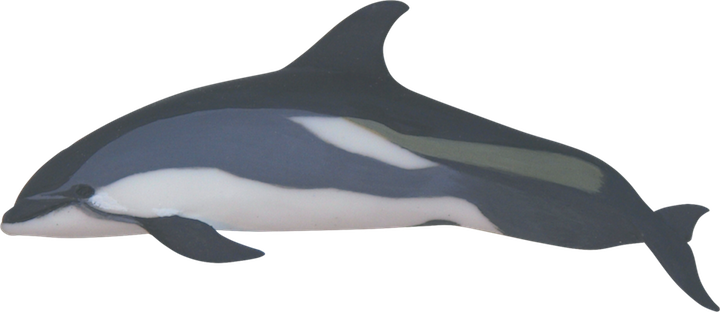
タイセイヨウカマイルカ
Atlantic white-sided dolphin
マイルカ科/Lagenorhynchus acutus
Maximum length: 2.8 m
Atlantic white-sided dolphins have rather strong bodies. They have bright and complex patterns on their skin. Their backs, dorsal fins, pectoral fins, and caudal fins are gray, and their bellies and lower jaws are white. Yellow patterns that extend from their white bellies to their tails are prominent.
They are mostly found in cold, temperate waters or near the Arctic, but at times, they have been found in coastal waters or in the center of the North Pacific Ocean.
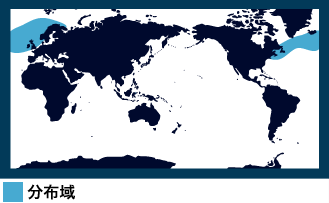
 White-beaked dolphin
White-beaked dolphin
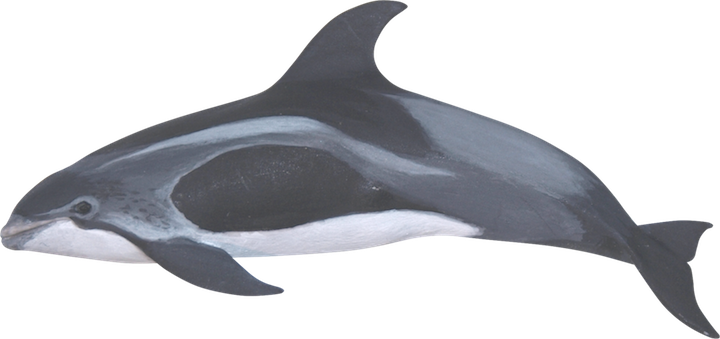
ハナジロカマイルカ
White-beaked dolphin
マイルカ科/Lagenorhynchus albirostris
Maximum length: 3.2 m
White-beaked dolphins are strong, and the males are larger than the females. Their black bodies have gray and white patches, and their beaks are short and either white or light-colored.
They are found in the temperate and subtropical waters of the North Atlantic Ocean mainly in the continental shelf area.
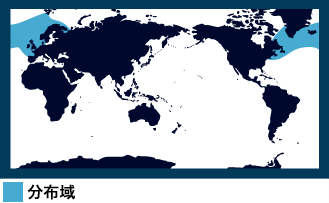
 Dusky dolphin
Dusky dolphin
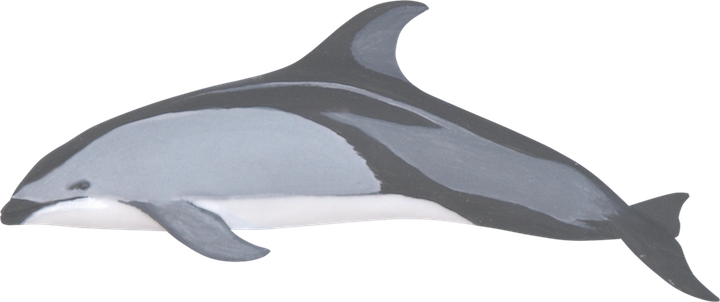
ハラジロカマイルカ
Dusky dolphin
マイルカ科/Lagenorhynchus obscurus
Maximum length: 2.1 m
Dusky dolphins have thinner and longer beaks compared to the related Pacific white-sided dolphin. The pattern on their heads from their blowholes to their beaks, and the white pattern which extends from their tails to their dorsal fins are characteristic of them.
Apart from an expansive area of cold, temperate waters in the Southern Hemisphere, they are also found in New Zealand and South Africa.
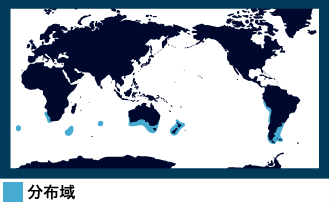
 Peale's dolphin
Peale's dolphin
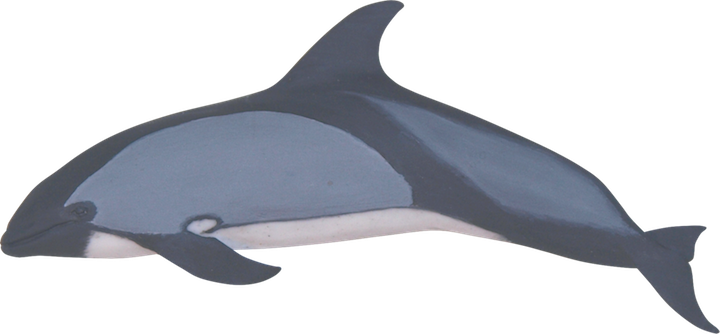
ミナミカマイルカ
Peale's dolphin
マイルカ科/Lagenorhynchus australis
Maximum length: 2.16 m
The color of Peale’s dolphins differs from one to another. Most commonly, their faces are a dark color while their throats and the sides of their bodies are white. The white marks at the base of their pectoral fins are their most notable characteristics. They have a wide gum line so that they can eat small octopi whole.
They are found on both sides of South America in deep waters in the southwest and in shallow waters in the southeast.
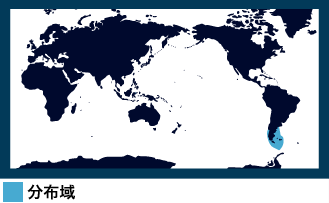
 Hourglass dolphin
Hourglass dolphin
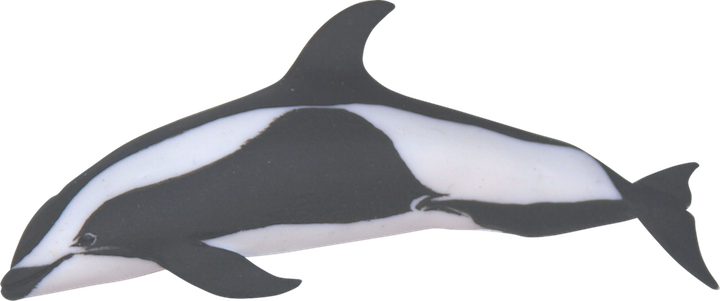
ダンダラカマイルカ
Hourglass dolphin
マイルカ科/Lagenorhynchus cruciger
Maximum length: 1.83 m
Hourglass dolphins have strong bodies that are mostly dark or black with two white ellipses at their sides which are connected by white lines, forming an hourglass shape.
They are found in the Antarctic between 40-67 degrees south latitude, and there are reports that they have been found near the coast and near islands.
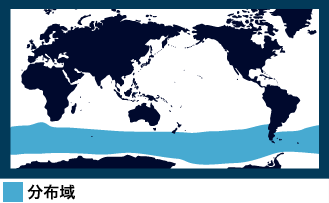
 Tucuxi
Tucuxi
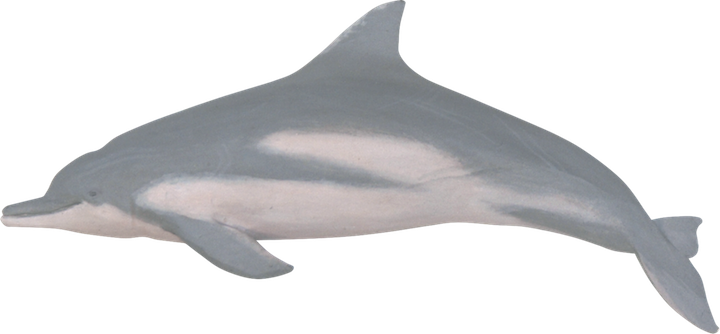
コビトイルカ
Tucuxi
マイルカ科/Sotalia fluviatilis
Maximum length: 2.1 m
Tucuxi have small, hard, streamlined bodies with gray backs and white or pink bellies. Angled dorsal fins in the center of their backs are characteristic of them.
They are only found in fresh water mainly in the Amazon in Brazil, Columbia, and Peru.
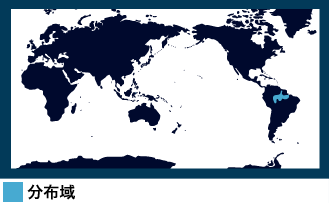
 Commerson's dolphin
Commerson's dolphin
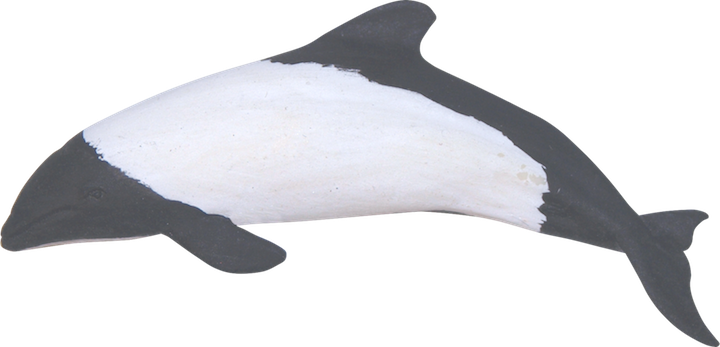
イロワケイルカ
Commerson's dolphin
マイルカ科/Cephalorhynchus commersonii
Maximum length: 1.75m
Commerson’s dolphins are small with rounded heads, dorsal fins, and pectoral fins. They are distinctly black and white. Although newborn calves are gray, they turn black and white after six months.
Two subspecies are recognized. One subspecies can be found in the coastal waters of Argentina in South America, while the other can be found in the coastal waters of the Kerguelen Islands.
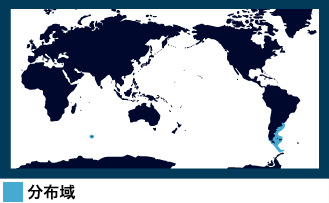
 Hector's dolphin
Hector's dolphin

セッパリイルカ
Hector's dolphin
マイルカ科/Cephalorhynchus hectori
Maximum length: 1.5 m
Hector’s dolphins are the smallest dolphins and are light gray with black pectoral, dorsal, and caudal fins. They also have a dark crescent mark above their blowholes and large, round dorsalfins.
Indigenous to New Zealand, the northeastern subspecies is only found along the northeastern portion of the west coast.

 Heaviside's dolphin
Heaviside's dolphin
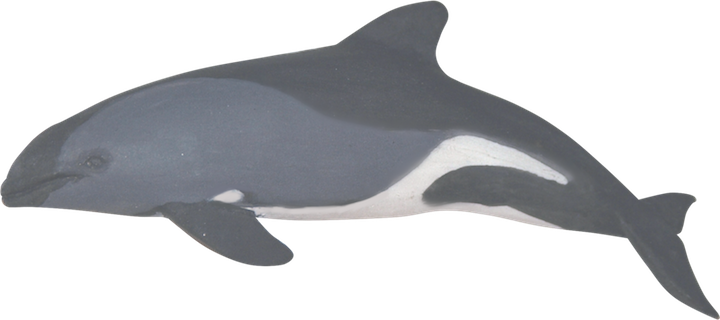
コシャチイルカ
Heaviside's dolphin
マイルカ科/Cephalorhynchus heavisidii
Maximum length: 1.7 m
Heaviside’s dolphins are the only species of Cephalorhynchus with round bodies and no dorsal fins. They have dark or black backs with gray heads and chests, and they have complicated white patterns on their bellies.
They are found in shallow waters less than 100 m deep off of the southwestern coast of Africa near 17 degrees south latitude.
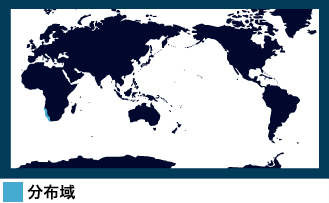
 Chilean dolphin
Chilean dolphin
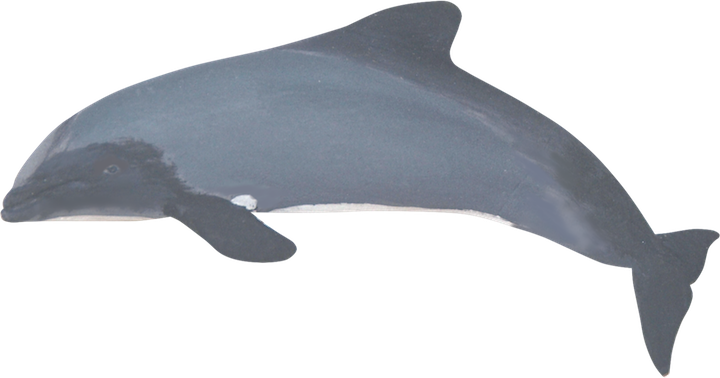
チリイロワケイルカ(ハラジロイルカ)
Chilean dolphin
マイルカ科/Cephalorhynchus eutropia
Maximum length: 1.7 m
Chilean dolphins have small bodies with round heads and pectoral fins which are characteristic of Cephalorhynchus. Their bodies are dark gray and their fins are black.
They are found along coastlines and fjords between Valparaiso, Chile, and Cape Cod.
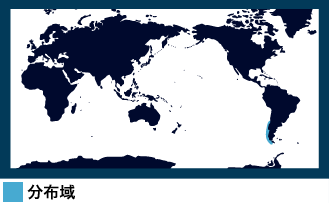
 Risso's dolphin
Risso's dolphin
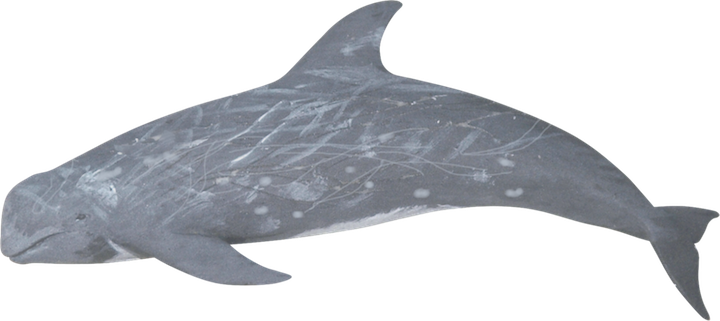
ハナゴンドウ
Risso's dolphin
マイルカ科/Grampus griseus
Maximum length: 3.8 m
Risso's dolphins have strong bodies with high and hooked dorsal fins at the center of their backs. Their dark gray bodies are covered with scars from scratches and getting bitten. They have protruding heads with vertical wrinkles.
They can be found in tropical and temperate waters in both hemispheres.
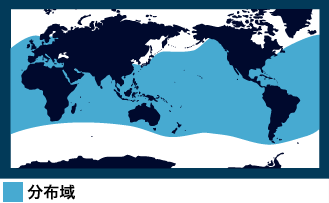
 Killer whale
Killer whale
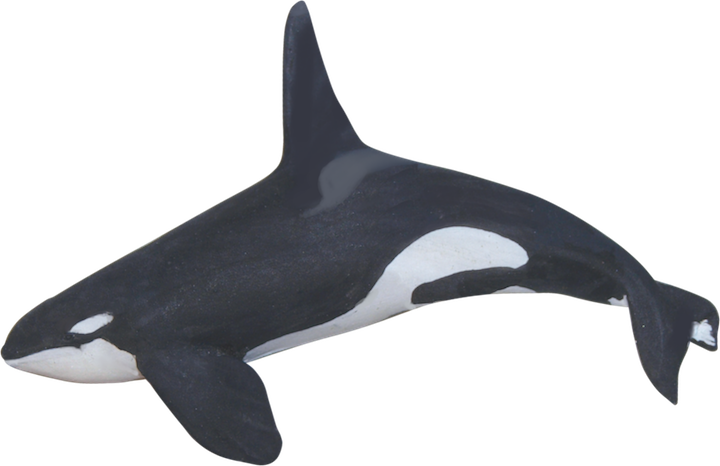
シャチ
Killer whale
マイルカ科/Orcinus orca
Maximum length: 9.8 m
Killer whales are characteristically a clear-cut white and black. They have white patches around their eyes, and a gray saddle-shape on their backs. They have large dorsal fins, and the males have larger ones than the females.
They are found in oceans all over the world.
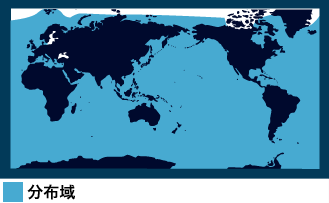
 Long-finned pilot whale
Long-finned pilot whale
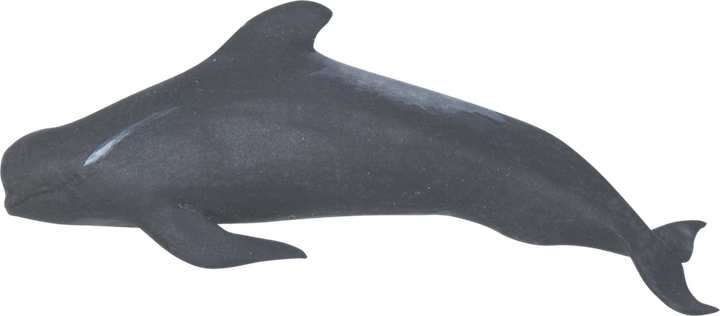
ヒレナガゴンドウ
Long-finned pilot whale
マイルカ科/Globicephala melas
Maximum length: 6.7 m
Long-finned pilot whales are the largest of the Delphinidae. The males have longer bodies than the females. Their large heads protrude forward, and their pectoral fins are 1/5 of their body length. They are found in cold, temperate waters and in sub-polar regions.
They are generally found in the open ocean, but sometimes they appear near the coast as well.

 Short-finned pilot whale
Short-finned pilot whale

コビレゴンドウ
Short-finned pilot whale
マイルカ科/Globicephala macrorhyncus
Maximum length: 6.1 m
Short-finned pilot whales have large, strong bodies with round, protruding heads. Their dorsal fins are hooked and low with rounded ends.
They are found in tropical and temperate waters all over the world. There are two geographical races in Japan.

 False killer whale
False killer whale
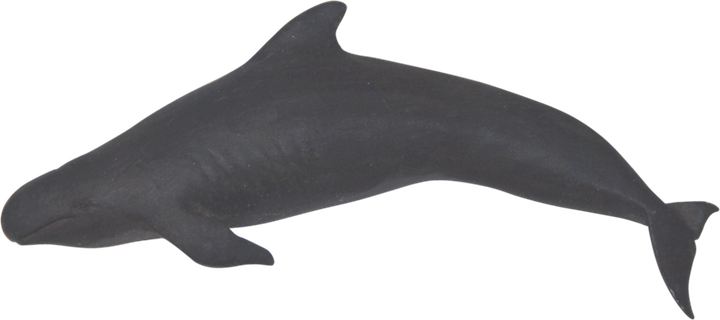
オキゴンドウ
False killer whale
マイルカ科/Pseudorca crassidens
Maximum length: 6 m
False killer whales have thin, slender bodies with prominent, black foreheads and narrow heads. Their pectoral fins are “S” shaped with a hump like an elbow.
They are found in deep, open, tropical and temperate waters, and occasionally they appear in coastal waters near islands.
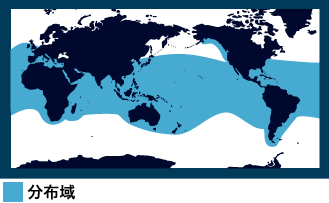
 Pygmy killer whale
Pygmy killer whale
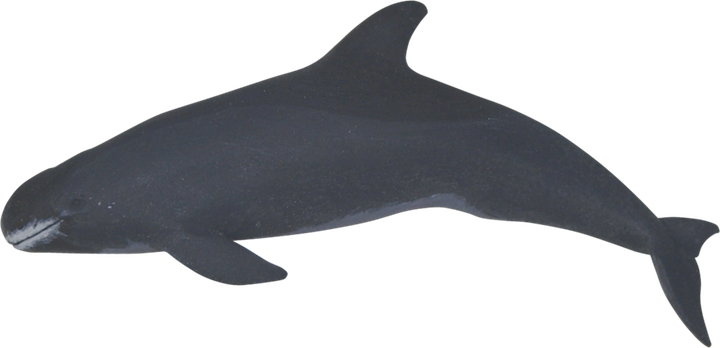
ユメゴンドウ
Pygmy killer whale
マイルカ科/Feresa attenuata
Maximum length: 2.6 m
Pygmy killer whales are similar to melon-headed whales in size and color; however, pygmy killer whales have rounder foreheads and their pectoral fins are rounded at the ends. Adults have white lips, and in many cases, their lower jaws are white at the ends as well.
They are found in deep, tropical and subtropical waters.
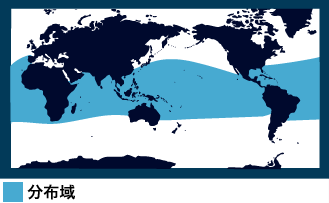
 Melon-headed whale
Melon-headed whale
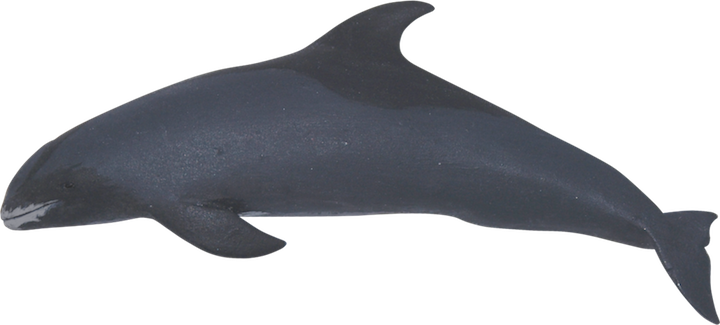
カズハゴンドウ
Melon-headed whale
マイルカ科/Peponocephala electra
Maximum length: 2.75 m
Melon-headed whales are easily mistaken for pygmy killer whales. Their bodies are dark gray with lighter bellies. Their heads slightly protrude, and they lack a distinct beak. The white part around their lips becomes distinct as they age. They have a characteristic large pattern below their dorsal fins.
They are found in deep, tropical and subtropical waters or in coastal waters near the islands of Hawaii and Polynesia.
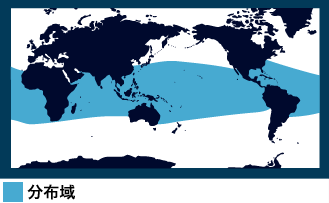
 Irrawaddy dolphin
Irrawaddy dolphin
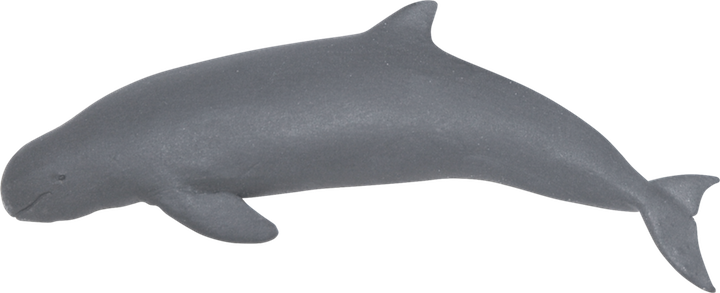
カワゴンドウ
Irrawaddy dolphin
マイルカ科/Orcaella brevirostris
Maximum length: 2.8 m
Irrawaddy dolphins have strong bodies with protruding heads. Slight wrinkles may be observed on their flexible necks. Their dorsal fins are slightly hooked and triangular in shape with a small, rounded tip.
They are found in coastal waters in South and Southeast Asia. In addition, they have been found in three large rivers and in two areas of brackish water.

 Australian snubfin dolphin
Australian snubfin dolphin
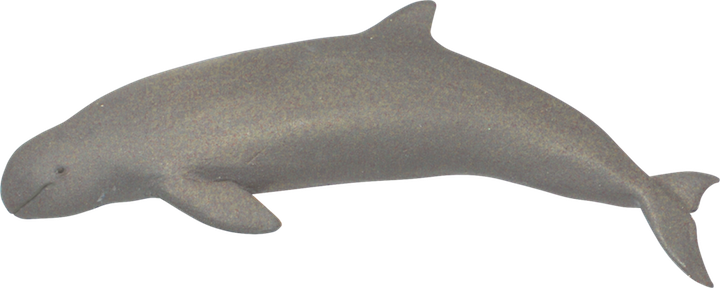
オーストラリアカワゴンドウ
Australian snubfin dolphin
マイルカ科/Orcaella heinsohni
Maximum length: 2.7 m
Australian snubfin dolphins characteristically have round heads with rounded beaks. Their backs are dark brown, their sides are light gray, and their bellies are white. Their oar-like pectoral fins are wide, and they can move them freely.
They are found in shallow, coastal waters and in rivers in northern Australia.
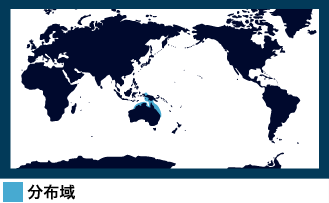
 Beluga
Beluga

シロイルカ
Beluga
イッカク科/Delphinapterus leucas
Maximum length: 5.5 m
Belugas have a characteristic thin ridge on their backs in place of a dorsal fin. They have small heads with a protruding forehead, and their small pectoral fins look like spatulas. They have wide caudal fins. Newborn calves are dark gray, which turn pure-white as they age.
They are found in the Arctic Ocean and the surrounding area.
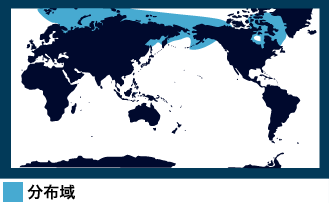
 Narwhal
Narwhal

イッカク
Narwhal
イッカク科/Monodon monocerus
Maximum length: 4.7 m
Narwhals are a brownish gray when they are born, and as they mature, their backs become dotted with black spots and their bellies turn white. In males, the left tooth grows in a helix spiral out of their upper lips, reaching as long as 3 m.
They are found on the Pacific side of the Arctic Ocean north of 60 degrees north latitude.
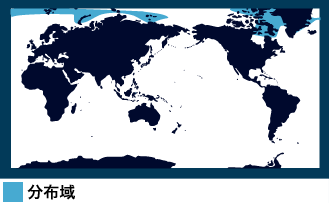
 Harbour porpoise
Harbour porpoise
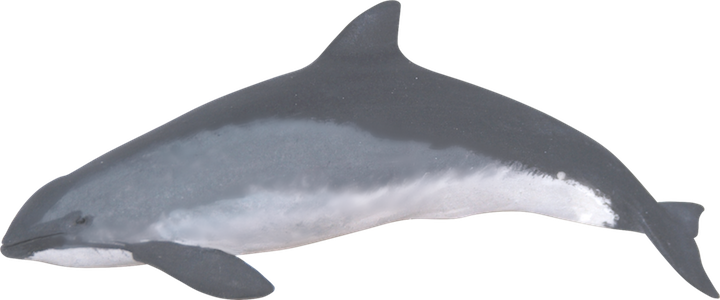
ネズミイルカ
Harbour porpoise
ネズミイルカ科/Phocoena phocoena
Maximum length: 2m
Harbour porpoises have short, stout bodies without a distinguishable beak. Their backs and caudal fins are dark gray or black, while their bellies are gray or white. Dark patterns around their eyes and dark lines from their mouths to their pectoral fins are characteristic of them.
They are found in temperate waters in the Pacific, Atlantic, and Arctic Oceans.
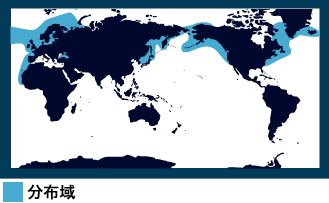
 Narrow-ridged finless porpoise
Narrow-ridged finless porpoise

スナメリ
Narrow-ridged finless porpoise
ネズミイルカ科/Neophocaena phocaenoides
Maximum length: 1.9 m
Narrow-ridged finless porpoises have relatively slender and flexible bodies, and they lack dorsal fins and beaks. They characteristically have prominent, round heads.
They are found off of the eastern coast of China, the Korean peninsula, and the coastal waters of Japan. There’s also a population in the Yangtze River.
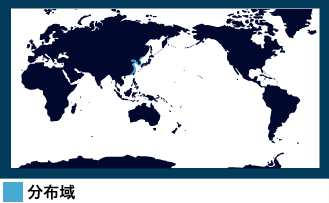
 Dall's porpoise
Dall's porpoise

イシイルカ
Dall's porpoise
ネズミイルカ科/Phocoenoides dalli
Maximum length: 2.4 m
Dall’s porpoises have thick bodies with small heads. They have characteristic white patches on their sides and lower bellies. The size of their patches differentiates between the two known types. The Dalli type has a narrower patch, while the Truei type has a wider one. Their dorsal and caudal fins turn white as they age.
They are found in temperate waters between the North Pacific and Arctic Oceans.
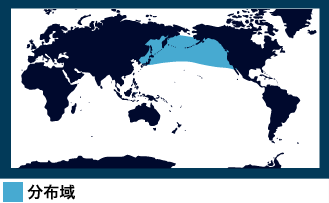
 Spectacled porpoise
Spectacled porpoise

メガネイルカ
Spectacled porpoise
ネズミイルカ科/Phocoena dioptrica
Maximum length: 2.3 m
Spectacled porpoises have small, round heads without beaks. They are known for the marks around their eyes which look like “spectacles.” Their backs and the upper parts of their sides are black, while their bellies and their lower sides are white. The males have large, round dorsal fins.
They are found around in Antarctica in between the Antarctic and Sub-Antarctic Oceans and temperate waters.
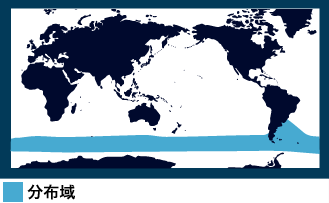
 Burmeister's Porpoise
Burmeister's Porpoise
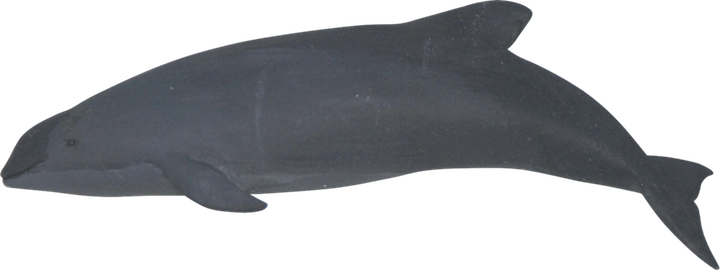
コハリイルカ
Burmeister's Porpoise
ネズミイルカ科/Phocoena spinipinnis
Maximum length: 2 m
Burmeister’s porpoises have short, stout bodies, small, round heads, and they lack beaks. Their bodies are almost entirely black, and their small, low dorsal fins are positioned on their lower backs. Dark marks around their eyes and dark lines from their eyes to their pectoral fins are characteristic of them.
They are found in coastal waters on both sides of South America reaching far north on the Pacific side due to the Peru Current.
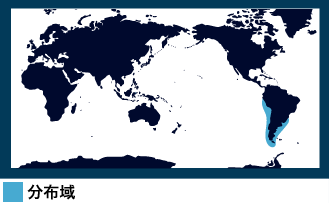
 Vaquita
Vaquita

コガシラネズミイルカ
Vaquita
ネズミイルカ科/Phocoena sinus
Maximum length: 1.5 m
Vaquita have tall dorsal fins for their body size, and their pectoral fins are longer than those of other porpoises. Marks around their eyes and mouths are characteristic of them. Their backs are dark gray, their sides are light gray, and their bellies are white.
They are found in shallow waters less than 30 m deep in the Gulf of California.
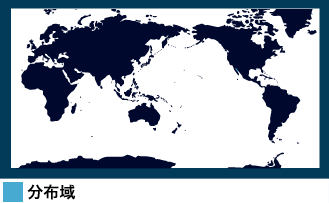
 Ganges river dolphin
Ganges river dolphin
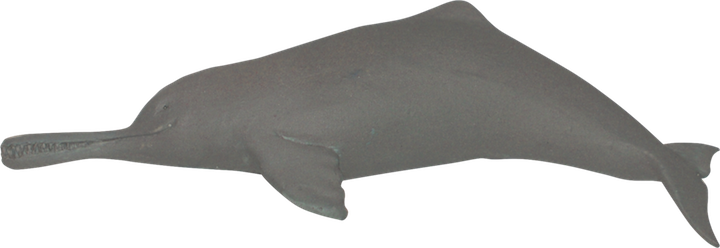
インドカワイルカ(ガンジスカワイルカ・インダスカワイルカ)
Ganges river dolphin
ネズミイルカ科/Platanista gangetica
Maximum length: 2.6 m
Ganges river dolphins are strong and have flexible necks with wrinkles. They are mostly dark brown. Their eyes are very small and are positioned just above the upward-bending corners of their mouths. Long, thin beaks and wide pectoral fins are characteristic of them.
They are found in the shallow, fresh waters of the Ganges, Brahmaputra, Meghna, Karnaphuli, and Sangu rivers that run through Nepal, India, and Bangladesh.

 Franciscana
Franciscana
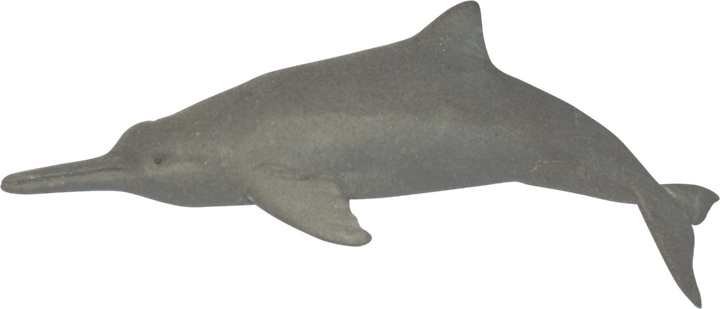
ラプラタカワイルカ
Franciscana
ラプラタカワイルカ科/Pontoporia blainvillei
Maximum length: 1.77 m
With small, brown bodies, Franciscana have the characteristics of river dolphins such as long, thin beaks, wide pectoral fins, and small, round dorsal fins. Their pectoral fin bones are prominent and visible, so they look like “fingers.”
They are found in the coastal waters and estuary areas of the South Atlantic (between southeast Brazil and northern Argentina).
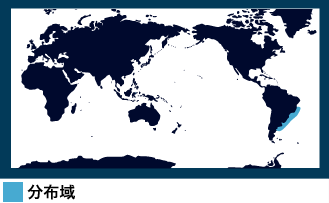
 Amazon river dolphin
Amazon river dolphin

アマゾンカワイルカ
Amazon river dolphin
アマゾンカワイルカ科/Inia geoffrensis
Maximum length: 2.8 m
Characteristic of Amazon river dolphins, they turn pink as they mature. They have strong, slim bodies with long, thin beaks, and their dorsal fins are low but long.
They are found in the fresh waters of the Amazon and the Orinoco rivers.
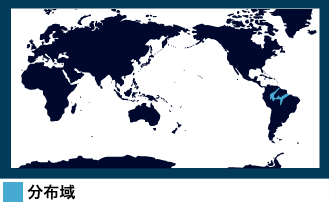
 Baiji
Baiji

ヨウスコウカワイルカ
Baiji
ヨウスコウカワイルカ科/Lipotes vexillifer
Maximum length: 2.6 m
Slightly upward-curving long, thin beaks and small eyes are characteristic of Baiji. In the 1980s, their populations drastically started to decrease due to the deterioration of their habitat, and in fact, they were declared functionally extinct in 2007.
They were found in the mid to lower parts of the Yangtze River.
